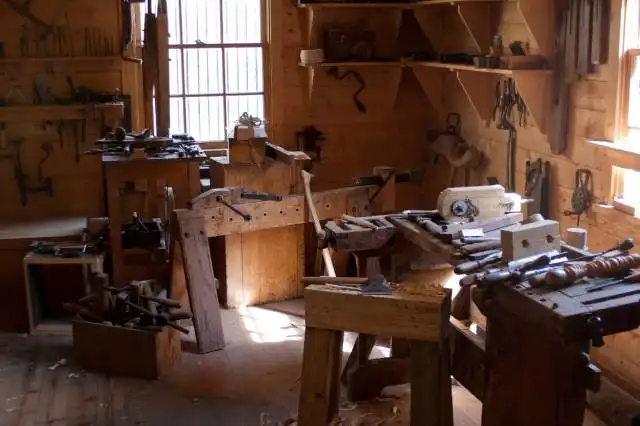Start a Stained Glass Business
Crafting a Prismatic Empire: Your Stained Glass Business Dream
| Updated


STAINED GLASS BUSINESS
Embarking on a stained glass business is like designing a kaleidoscope of possibilities! As a curious entrepreneur, you'll fashion vibrant, artistic masterpieces to transform dull windows into lively narratives, or even delicate jewelry pieces. From bespoke designs to restoration works, this type of business typically caters to private homeowners, churches, or commercial buildings, creating custom pieces that infuse color and creativity into any space. Get ready to let your artistry shine and reflect off the prismatic world of stained glass.
Jump to Business Plan
RELATED BUSINESS IDEAS
Browse ALL Arts & Crafts Business Ideas
Discover Your Perfect Domain
Unlock the door to your online success with our hand-picked selection of premium domain names. Whether you're starting a new venture or rebranding an existing one, the right domain can set the tone for your digital presence. Browse through our curated list, each with its unique potential to enhance your brand's visibility and credibility.
STAINED GLASS MINI BUSINESS PLAN
This a quick reality check to help you identify the strengths and weaknesses of your business concept before you dive in.
Expected Percent Margin:
- Gross Margin: 70-80%
- Net Profit Margin: 20-30%
Earnings Expectations:
- Daily Earnings: $150 - $400
- Weekly Earnings: $750 - $2,000
- Monthly Earnings: $3,000 - $8,500
- Annual Earnings: $36,000 - $102,000
Actions to Hit Those Numbers:
Inventory Management:
- Initial Investment: At least $10,000-$20,000 for stained glass supplies, tools and work space.
- Supplier Network: Develop relationships with glass supply companies.
Marketing and Customer Acquisition:
- Social Media: Create an Instagram account and post high quality photos of your work regularly.
- Local Advertising: Join local artisan, craft, and flea markets to showcase your stained-glass art.
Sales and Customer Experience:
- Online Sales: Set up an Etsy shop for online sales.
- Custom Orders: Offer customized solutions and personal consultations for unique designs.
Cost Control:
- Workspace: Utilize a home studio if possible to save on rent.
- Utilities and Maintenance: Budget around $200-$300 per month.
Business Operations:
- Production Time: Ensure you can produce enough items to meet demand, aim to produce 1-2 items per day.
- Pricing: Price your items based on complexity, time spent, and material cost.
These are generalized estimations and can vary depending on local raw material cost, demand for stained glass items, and individual skill level among many other factors. Always consult with a financial advisor for personalized advice.
NOT WHAT YOU HAD IN MIND? Here are more ideas



Browse ALL Arts & Crafts Business Ideas
Grab Your Business Website Name
Before you get caught up in the whirlwind of setting up your business, invest in a domain name. It's a small but significant step that lays the foundation for your brand and makes it easier for customers to find and trust you. Just like you wouldn't build a house without securing the land first, don't build a business without securing your domain name.
"Why? Can't that wait?" Here's why it shouldn't
Step 1: Determining if the Business is Right for You
Breakdown of Startup Expenses
Before starting a stained glass business, it is important to understand the startup costs associated with the endeavor. This includes the cost of materials, such as glass, solder, and tools, as well as the cost of renting or purchasing a workspace. Additionally, the cost of marketing and advertising should be taken into consideration. It is also important to consider the cost of any licenses or permits that may be required to operate a business. Finally, it is important to factor in the cost of insurance, which will protect the business from any potential liabilities.
Breakdown of Ongoing Expenses
Once the business is established, there are ongoing expenses to consider. This includes the cost of supplies and materials, as well as the cost of any repairs or replacements that may be needed. Additionally, the cost of marketing and advertising should be taken into consideration. It is also important to factor in the cost of any licenses or permits that may be required to operate a business. Finally, it is important to factor in the cost of insurance, which will protect the business from any potential liabilities.
Examples of Ways to Make Money
There are a number of ways to make money with a stained glass business. One of the most popular ways is to offer custom designs and services to customers. Additionally, selling stained glass kits and supplies is another way to make money. Finally, offering classes and workshops is a great way to generate additional income. It is important to consider all of these options when determining the best way to make money with a stained glass business.
Step 2: Naming the Business
When it comes to naming a business, it is important to choose a name that is memorable and that accurately reflects the services that the business provides. It is also important to make sure that the name is not already taken by another business. Here are some tips for coming up with a unique and memorable name for a stained glass business:
Brainstorm: Take some time to brainstorm potential names for the business. Think of words that are associated with stained glass, such as “light”, “glass”, “art”, or “color”. Also, consider using words that reflect the area or city that the business is located in.
Research: Once you have a few potential names, it is important to research them to make sure that they are not already taken. Check to see if the domain name is available and if the name is already trademarked.
Get Feedback: Ask friends and family for their opinion on potential names. They may be able to provide helpful feedback that can help you narrow down your list of potential names.
Keep It Simple: Try to keep the name as simple as possible. A complicated name can be difficult to remember and can be hard to spell.
Make It Unique: Try to make the name unique and memorable. Consider using a combination of words or a play on words to make the name stand out.
Step 3: Creating a Business Plan
Outlining Goals and Objectives
When creating a business plan, it is important to outline your goals and objectives. This should include what you want to achieve with your business, the timeframe for achieving it, and the resources you will need to get there. You should also consider the potential risks and rewards associated with the business and how you will manage them. Additionally, you should consider the overall market for stained glass products and how you can differentiate your business from the competition.
Establishing a Budget
Establishing a budget is a crucial part of creating a business plan. This should include both startup costs and ongoing expenses. Startup costs can include things like purchasing supplies, renting a workspace, and advertising. Ongoing expenses can include things like rent, utilities, and employee wages. Additionally, you should consider the cost of any necessary licenses or permits, as well as any taxes or fees associated with running a business.
Identifying Target Market
Identifying your target market is an important part of creating a business plan. This should include researching the types of customers who are most likely to purchase your products, as well as the best ways to reach them. You should also consider the competition in the area and how you can differentiate your business from them. Additionally, you should consider any potential partnerships or collaborations that could help you reach your target market.
Step 4: Obtaining Necessary Licenses and Permits
Researching Local and State Requirements
Before applying for any licenses or permits, it is important to research the local and state requirements for starting a stained glass business. Depending on the state, there may be different requirements for registering a business name, obtaining a business license, and applying for any necessary permits. It is important to research the local and state requirements to ensure that the business is in compliance with all regulations.
Applying for Necessary Licenses and Permits
Once the local and state requirements have been researched, the next step is to apply for the necessary licenses and permits. This may include applying for a business license, registering the business name, and applying for any necessary permits. Depending on the state, the application process may vary. It is important to make sure that all applications are completed correctly and submitted in a timely manner.
Once the applications have been submitted, it is important to follow up with the local and state agencies to ensure that the applications have been received and are being processed. It is also important to keep copies of all applications and any correspondence with the local and state agencies. This will help ensure that the business is in compliance with all regulations and will help avoid any potential legal issues.
Step 5: Securing Financing
Exploring Funding Options
Before applying for a loan, it is important to explore all possible funding options. This includes researching grants, crowdfunding, angel investors, and other sources of capital. Grants are a great way to secure funding without having to pay it back. Crowdfunding is a popular way to raise money for a business, and angel investors can provide a large sum of money with a higher return.
Applying for Loans
Once all possible funding options have been explored, it may be necessary to apply for a loan. This can be done through a bank, credit union, or online lender. It is important to research the different types of loans available and compare interest rates, repayment terms, and other factors. When applying for a loan, it is important to have a business plan and financial projections ready to show the lender. This will help demonstrate the potential success of the business and increase the chances of getting approved.
Step 6: Finding a Location
Identifying Ideal Location
When looking for a location for a stained glass business, there are several factors to consider. First, the location should be in an area that is easily accessible to customers. It should also have enough space to accommodate the necessary equipment and supplies. Additionally, the location should have plenty of natural light, as this is essential for working with stained glass. Finally, the location should be affordable and have the necessary utilities.
Negotiating Lease Terms
Once an ideal location has been identified, it is important to negotiate the best terms for a lease. This includes the length of the lease, the amount of rent, and any additional fees. It is also important to ensure that the lease allows for the necessary renovations and modifications to the space. Additionally, the lease should include provisions for the business to expand if needed. Finally, it is important to make sure that the lease includes provisions for the business to terminate the lease if necessary.
Step 7: Purchasing Equipment
Identifying Necessary Equipment - Before purchasing any equipment, it is important to identify what is needed to start a stained glass business. This includes items such as glass cutters, grinders, soldering irons, and other tools. It is also important to consider the type of glass that will be used. Different types of glass require different tools and supplies.
Researching Suppliers - Once the necessary equipment has been identified, it is important to research suppliers to find the best prices. Many suppliers offer discounts for bulk orders, so it is important to compare prices and quality. It is also important to consider the shipping costs associated with each supplier. Many suppliers offer free shipping for orders over a certain amount. It is also important to consider the return policies of each supplier in case the equipment needs to be returned.
Step 8: Marketing the Business
Developing a marketing plan is an important step in starting a stained glass business. A marketing plan should include a detailed list of the target market, the services offered, and the pricing structure. It should also include a timeline for when the business will launch, how it will be promoted, and how it will be evaluated. Additionally, it should include a budget for marketing activities and a plan for tracking results.
Utilizing social media is an effective way to market a stained glass business. Creating a website, blog, and social media accounts can help to spread the word about the business. Additionally, creating content such as tutorials, videos, and images can help to engage potential customers and build a following. Utilizing social media platforms such as Facebook, Instagram, and Twitter can also help to reach a wider audience. Additionally, utilizing paid advertising on social media can help to reach even more potential customers. Finally, creating a newsletter or email list can help to keep customers informed about new products and services.
Step 9: Hiring Employees
Identifying Needed Positions
Before hiring any employees, it is important to identify the positions needed to run the stained glass business. This could include positions such as a stained glass artist, a salesperson, a customer service representative, and a bookkeeper. It is important to consider the size of the business and the amount of work that needs to be done. For example, if the business is small, it might not be necessary to hire a full-time salesperson.
Creating Job Descriptions
Once the necessary positions have been identified, it is important to create job descriptions for each position. This should include a detailed description of the duties and responsibilities of each position. It should also include the qualifications and experience required for each position. This will help to ensure that the right person is hired for the job.
Recruiting and Hiring
Once the job descriptions have been created, it is time to start recruiting and hiring employees. This can be done through a variety of methods such as job postings, online job boards, and networking. It is important to take the time to find the right person for the job. This includes conducting interviews, background checks, and reference checks. Once the right person has been found, it is important to provide them with a comprehensive job offer that includes salary, benefits, and other incentives.
EXPLORE MORE CATEGORIES
Browse ALL Business Idea Categories
TAKE THE NEXT STEPS










